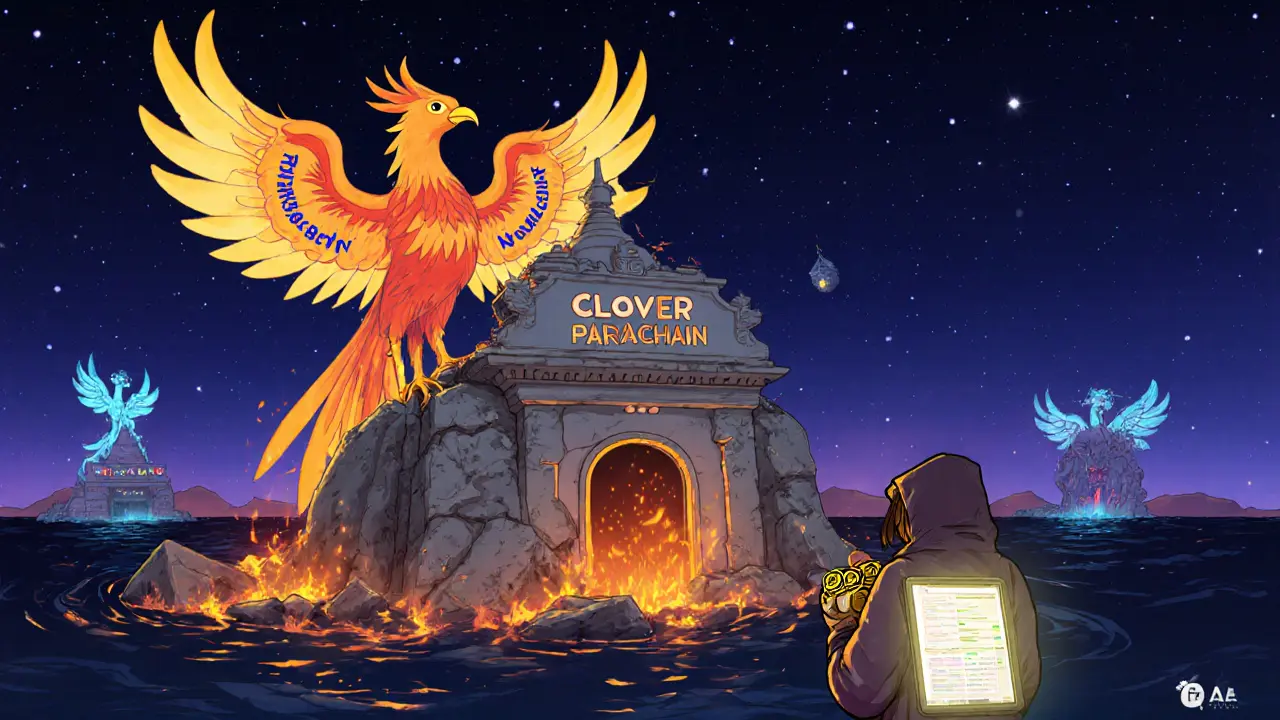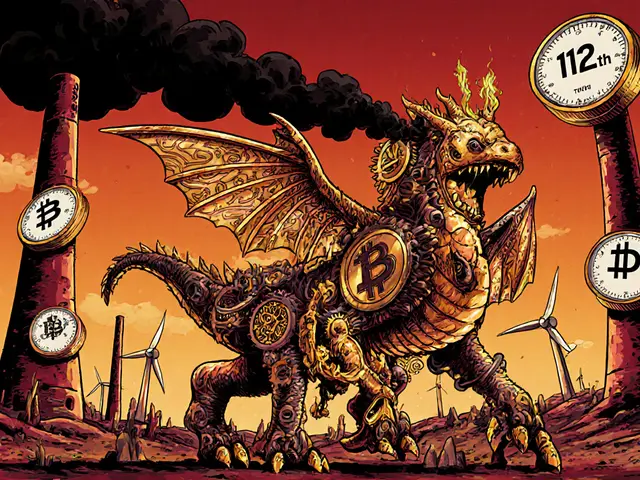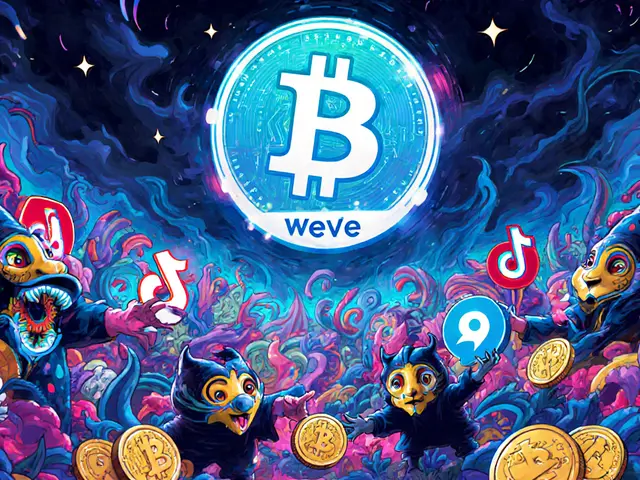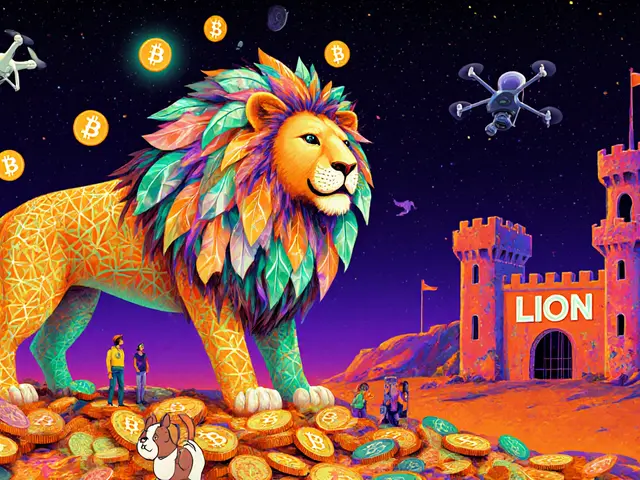Most crypto exchanges are built for the big players - Uniswap on Ethereum, PancakeSwap on BSC, or dYdX on Starknet. But what if you’re not trading ETH or BNB? What if you’re deep in the Polkadot ecosystem, holding CLV, MOVR, or one of the smaller parachain tokens? That’s where Huckleberry comes in. It’s not the biggest exchange out there. It doesn’t have thousands of trading pairs. But if you’re already using Clover or Moonriver, Huckleberry might be the only DEX that actually works the way you need it to.
What Is Huckleberry?
Huckleberry is a decentralized exchange (DEX) and lending platform built on two blockchains: Clover Finance and Moonriver. It launched in 2022 with a clear mission: serve users who want to swap, stake, farm, lend, and bridge assets without leaving the Polkadot ecosystem. Unlike Uniswap, which runs on Ethereum, or SushiSwap on multiple chains, Huckleberry is hyper-focused. It doesn’t try to be everything to everyone. It’s built for the drifters - the ones who live in the gaps between chains.The platform’s tagline, “Let the drifters guide you,” isn’t just marketing. It reflects its design. Huckleberry doesn’t force you to learn a new wallet, a new gas system, or a new bridge. It uses Clover’s existing infrastructure to make cross-chain DeFi feel seamless. You connect your wallet - usually the Clover extension - and you’re already halfway there.
How Huckleberry Works
Huckleberry runs on Clover Finance’s Substrate-based blockchain, which is EVM-compatible. That means you can use MetaMask or other Ethereum wallets to interact with it, even though you’re on a Polkadot parachain. This is a big deal. Most Polkadot projects require you to use Polkadot.js or a niche wallet. Huckleberry removes that friction.Here’s how it actually works in practice:
- You connect your wallet (Clover Wallet, MetaMask, or others)
- You swap tokens like CLV, MOVR, or USDC between chains
- You stake your LP tokens to earn rewards
- You lend assets and earn interest
- You vote on governance proposals
- You bridge assets from Ethereum to Polkadot without third-party intermediaries
What makes this different? Clover’s built-in 2-way peg (2WP) system. Most bridges require you to lock tokens on one chain and mint them on another. That means trusting a smart contract or a group of oracles. Clover’s system uses Merkle proofs to verify transactions directly between chains. It’s trust-minimized. You’re not handing your ETH to a team of developers - you’re sending it to a verifiable on-chain mechanism.
And here’s the kicker: no gas fees in the traditional sense. On Ethereum, you need ETH to pay for every transaction. On Huckleberry, fees are deducted from the asset you’re swapping. If you’re swapping CLV for MOVR, the fee comes out of your CLV. No need to hold extra tokens just to pay for gas. That’s a huge win for beginners and people with small balances.
What Tokens Can You Trade?
As of late 2023, Huckleberry supports 10 tokens and 16 trading pairs. That’s tiny compared to Uniswap’s 14,000+ pairs. But it’s not about volume - it’s about relevance.Here’s what you’ll actually find:
- CLV (Clover Finance’s native token)
- MOVR (Moonriver’s native token)
- USDC (on Clover’s EVM layer)
- DAI
- WBTC
- WETH
- DOT (via bridge)
- Other parachain tokens like Acala’s ACA and Karura’s KAR
Notice something? No Shiba Inu. No Dogecoin. No meme coins. Huckleberry doesn’t chase hype. It focuses on tokens that have real utility within the Polkadot and Moonriver ecosystems. If you’re holding CLV or MOVR and want to swap them for stablecoins or wrapped assets, this is one of the few places you can do it without jumping through hoops.

How It Compares to Other DEXs
Let’s put Huckleberry in context.| Feature | Huckleberry | Uniswap | PancakeSwap | Curve |
|---|---|---|---|---|
| Chain | Clover + Moonriver | Ethereum | Binance Smart Chain | Ethereum |
| Trading Pairs | 16 | 14,000+ | 1,200+ | 500+ |
| Gas Fees | Deducted from traded asset | ETH required | BNB required | ETH required |
| Cross-Chain Bridge | Native (Ethereum ↔ Polkadot) | No | No | No |
| Best For | Polkadot/Moonriver users | ETH and ERC-20 traders | BNB and BSC traders | Stablecoin swaps |
Huckleberry doesn’t compete with Uniswap. It competes with bridges like Synapse or Across - but it’s built into the exchange. That’s rare. Most DEXs are chain-specific. Huckleberry is ecosystem-specific. If you’re already in Clover, you don’t need to go elsewhere to bridge. You do it right in the swap interface.
The Downsides
Let’s be honest - Huckleberry isn’t perfect.First, liquidity is thin. With only 16 trading pairs, you’ll often get poor slippage on larger trades. If you’re trying to swap $5,000 worth of CLV, you might end up with less than expected. That’s normal for small DEXs, but it’s still a pain.
Second, there’s almost no user feedback. No Reddit threads. No Trustpilot reviews. No YouTube tutorials. You won’t find anyone saying, “I saved $200 on fees using Huckleberry.” Or, “I lost my funds because of a bug.” The silence is deafening. That’s not a red flag - it’s a warning. No reviews means no community. No community means no pressure to improve.
Third, it’s tied to Clover’s future. Clover won Polkadot’s Auction 5 in 2021 with nearly 10 million DOT. But that parachain lease expired in October 2023. If Clover doesn’t win the next auction, Huckleberry’s entire infrastructure could vanish. There’s no backup plan announced. No migration path. That’s a major risk.
And finally - no mobile app. You have to use a browser. No Android or iOS app. If you’re used to trading on your phone, this will feel clunky.

Who Is This For?
Huckleberry isn’t for everyone. But it’s perfect for three types of people:- Polkadot/Moonriver holders - If you have CLV, MOVR, or other parachain tokens and want to trade them without using centralized exchanges, this is one of the few options.
- Cross-chain traders - If you want to move ETH to CLV without using a bridge like Wormhole or Multichain, Huckleberry’s native bridge is the cleanest path.
- DeFi beginners - The gas-free model makes it easier to test DeFi without needing to buy ETH or BNB just to pay fees.
If you’re just starting out in crypto and want to trade BTC or ETH on a big exchange, skip Huckleberry. Go to Coinbase or Kraken. But if you’re already in the Polkadot world and want to keep your assets decentralized, this is one of the few tools that actually fits your workflow.
Is It Safe?
No audits have been publicly released for Huckleberry’s smart contracts. That’s a concern. Clover Finance’s core infrastructure has been reviewed by third parties, but Huckleberry’s codebase hasn’t been published for public scrutiny. That’s a gap.That said, the platform doesn’t hold your funds. It’s a DEX - you connect your wallet, and trades happen peer-to-peer. No custodial risk. No team can steal your assets. The risk is in the smart contracts - if there’s a bug, you could lose funds during a swap or liquidity provision.
There’s no insurance fund. No bug bounty program. No security council. Just code running on a parachain that may or may not continue to exist. If you’re risk-averse, avoid it. If you’re okay with experimenting on the edge of DeFi, it’s worth a small test.
The Bottom Line
Huckleberry isn’t a top 10 DEX. It won’t replace Uniswap. But it fills a real gap: a native, gas-free, cross-chain swap tool for the Polkadot and Moonriver communities. It’s niche. It’s quiet. It’s under-the-radar. And that’s exactly why it matters.If you’re holding CLV or MOVR, and you want to trade them without touching a centralized exchange, Huckleberry is one of the only tools that makes sense. The liquidity is low, the reviews are absent, and the future depends on Clover winning another parachain slot. But for those who need it - it works.
Try it with a small amount. Swap $10 of CLV for MOVR. See how the bridge feels. Test the interface. If it’s smooth, you’ve found a hidden gem. If it’s clunky or slow - you’ve saved yourself from a bigger loss.
It’s not the future of crypto. But for a small corner of it? It’s already here.
Is Huckleberry a centralized exchange?
No, Huckleberry is a decentralized exchange (DEX). You connect your own wallet - like Clover Wallet or MetaMask - and trades happen directly between users via smart contracts. No one holds your funds. There’s no KYC. No account creation. It’s fully non-custodial.
Can I use Huckleberry on my phone?
Not natively. Huckleberry has no official mobile app. You can access it through a mobile browser by connecting your wallet (like Clover Wallet for Android or iOS), but the interface isn’t optimized for small screens. For the best experience, use a desktop or laptop.
Do I need CLV to use Huckleberry?
No, you don’t need CLV to trade. You can swap other tokens like MOVR, USDC, or WETH. But if you want to stake, farm, or vote on governance, you’ll need CLV. It’s the platform’s native token for rewards and participation.
Is Huckleberry safe to use?
Huckleberry doesn’t hold your funds, so there’s no risk of a hack like a centralized exchange. But the smart contracts haven’t been publicly audited. There’s no insurance or bug bounty program. Use only small amounts you’re willing to risk. Avoid large deposits until more transparency is provided.
What happens if Clover loses its Polkadot parachain slot?
If Clover doesn’t win the next parachain auction, Huckleberry’s infrastructure could become unusable. There’s no announced migration plan. The platform is entirely dependent on Clover’s continued operation on Polkadot. This is the biggest risk to using Huckleberry long-term.
How do I connect my wallet to Huckleberry?
Go to huckleberry.finance and click “Connect Wallet.” You can use Clover Wallet, MetaMask, or other EVM-compatible wallets. Make sure your wallet is connected to the Clover network (Chain ID 1000 or Moonriver 1285). The site will guide you through adding the network if needed.











18 Comments
Huckleberry? More like Huckle-broke. I tried swapping 5 CLV and got 3.7 MOVR after slippage. That's not DeFi, that's a tax on patience. And no mobile app? In 2024? Come on.
The lack of audits is frankly alarming. I don't care how 'niche' it is-if the code isn't public and reviewed, it's not DeFi. It's a gamble with your private keys. And calling it 'trust-minimized' when the bridge relies on a single parachain's survival? That's not innovation. That's negligence.
OH MY GOD!!! This is literally the ONLY thing keeping Polkadot alive!!! I mean, have you SEEN the liquidity on Uniswap?? It's a graveyard of meme coins and rug pulls!!! Huckleberry is the last bastion of REAL DeFi!!! CLV to MOVR in one click?? NO GAS FEES?? IT'S A MIRACLE!!! I CRIED WHEN I SWAPPED MY FIRST 0.5 DOT!!! THIS IS THE FUTURE!!!
What's fascinating here is the ontological shift from chain-centric to ecosystem-centric DeFi. Huckleberry doesn't merely aggregate liquidity-it operationalizes composability within a constrained governance framework. The 2WP mechanism, leveraging Merkle proofs for cross-chain verification, represents a non-custodial infrastructural innovation that subverts the traditional bridge paradigm. The absence of native gas tokens is not a feature-it's a epistemic reorientation of value transfer semantics. This is not a DEX. It's a lattice of interoperable trust primitives.
So let me get this straight-you're telling me I have to trust a project that has ZERO reviews, no app, and might vanish if a team loses a lottery?? And you call this 'the future'? I'm not even mad. I'm just disappointed. Like, I spent 20 minutes trying to connect my wallet and now I'm questioning all my life choices. This isn't DeFi. It's a haunted house with a gas fee.
If you're already in the Polkadot ecosystem, Huckleberry is worth testing-even with a tiny amount. It’s not about competing with Uniswap. It’s about solving a real problem: cross-chain swaps without jumping through 10 bridges. The interface is clunky, sure. The liquidity is thin. But if you're tired of paying $50 in ETH gas just to swap a few tokens, this is one of the few places that actually respects your balance. Try it with $10. If it works, you’ll feel like you found a secret passageway.
Big fan of the gas-free model. I’ve been using it for a month now-swap CLV to USDC, stake LP, vote on proposals. No drama. No panic. Just smooth. I do wish there was more documentation, but honestly? It’s the most straightforward thing I’ve used in Polkadot land. The fact that it uses MetaMask? Huge win. I didn’t have to learn a new wallet. That’s rare.
Wait-you’re telling me this platform doesn’t even have a public GitHub repo? No audit? No bug bounty? No team addresses? And you’re seriously recommending this to people?? This isn’t ‘niche,’ this is a honeypot. I’ve seen this movie before. The devs disappear after the first $500k in TVL. And now you’re telling me to ‘try it with $10’? That’s not a test. That’s a donation.
I’ve been using Huckleberry for six months. I’m not a degenerate trader-I just hold CLV and MOVR from early staking. I use it to swap small amounts for stablecoins when I need cash. It’s slow. It’s quiet. But it’s never failed me. I don’t need hype. I don’t need a million pairs. I just need it to work when I need it. And it does. That’s enough for me.
This is a CIA operation disguised as a DEX. Clover Finance was funded by a Chinese blockchain consortium. The parachain lease expiration? A distraction. They want you to lock in your assets before the switch. Then they’ll fork the chain, drain the liquidity, and launch Huckleberry 2.0 under a new name. No audits? No reviews? That’s not negligence-it’s a cover-up. Don’t touch this with a 10-foot pole.
So we’re supposed to be impressed that a DEX doesn’t charge gas… because it steals from your trade instead? Brilliant. Next they’ll charge you a fee to breathe. And calling it ‘trust-minimized’ when it’s entirely dependent on one parachain that might vanish next week? That’s not innovation. That’s a magic trick where the rabbit is your entire portfolio.
You guys are overthinking this. Huckleberry is trash. Why use it when you can just bridge to Ethereum and use Uniswap? Everyone knows Ethereum is the only real chain. Everything else is just noise. Clover? Moonriver? Who even uses those? This is just another altcoin scam trying to look legit. I’ve seen this a hundred times. The devs are long. You’re the bagholder.
I really appreciate that this exists. I know it’s small. I know it’s quiet. But I’ve been trying to get my mom to use DeFi for years-she’s terrified of gas fees and complex wallets. Huckleberry is the first thing she actually understood. She swapped $5 of CLV for USDC and said, ‘That was easier than my bank app.’ That’s not nothing. Sometimes the quiet tools are the ones that change lives.
Just tried it. Swapped $10 of CLV to MOVR. Took 45 seconds. No drama. No gas panic. Interface is simple. Didn’t even need to read the docs. If you’re in the ecosystem? Give it a shot. Small test. No big deal. Worst case? You lose $10. Best case? You found your new favorite tool.
I’m glad someone wrote this. I’ve been using Huckleberry for months but never saw anyone talk about it. It’s not flashy, but it just… works. I don’t need hype. I don’t need a million users. I just need reliability. And for my use case? It’s perfect.
THIS IS A SCAM. I LOST MY ENTIRE PORTFOLIO BECAUSE OF THIS. I SWAPPED 20 DOT AND IT JUST VANISHED. NO REFUND. NO SUPPORT. NO EXPLANATION. I SPENT 8 HOURS ON LIVE CHAT AND THEY JUST SAID 'TRY AGAIN'. I’M SENDING THIS FROM MY PHONE BECAUSE MY LAPTOP WAS TAKEN AWAY AFTER I CRIED FOR 3 HOURS. YOU PEOPLE ARE ALL IN DANGER. DON’T TRUST THIS. DON’T EVEN LOOK AT IT. I’M SENDING THIS TO THE SEC RIGHT NOW.
The architectural elegance of Huckleberry lies not in its scale, but in its intentional constraint. By anchoring itself to Clover’s 2WP mechanism, it eliminates the trust assumptions inherent in external bridges. The fee structure-deducted from the traded asset-is a subtle but profound decentralization of liquidity burden. While the absence of audits is concerning, the non-custodial nature of the platform mitigates systemic counterparty risk. This is not a product for mass adoption. It is a prototype for a new class of ecosystem-native DeFi primitives-where utility supersedes volume, and resilience is measured not in TVL, but in functional continuity. The real question is not whether Huckleberry will survive-but whether the broader DeFi ecosystem will recognize the value of its quiet, focused design.
Why are we even talking about this? America’s the future of crypto. Everything else is just leftovers. Clover? Moonriver? Who even cares? If you’re not on Ethereum or Solana, you’re not in the game. This is just another foreign crypto gimmick trying to steal attention. We don’t need niche DEXs-we need dominance. And Huckleberry? It’s not a tool. It’s a distraction.